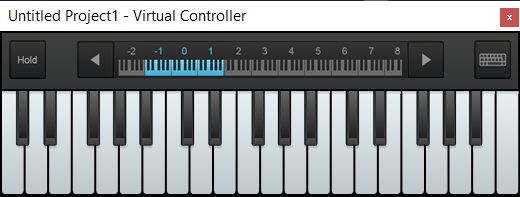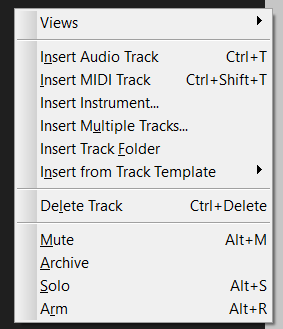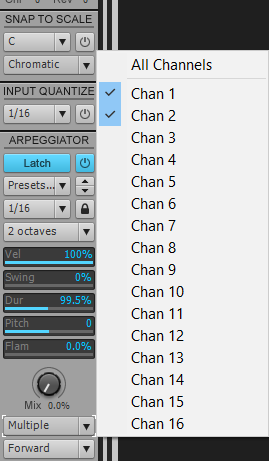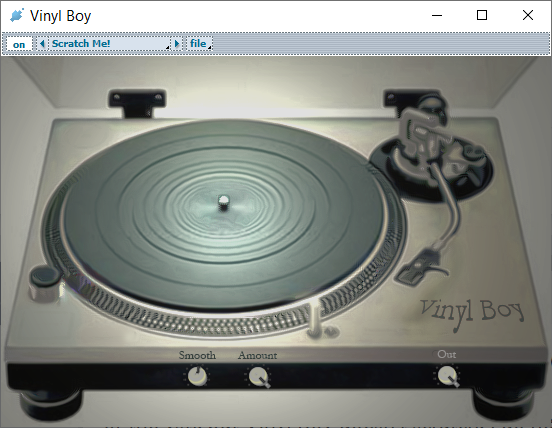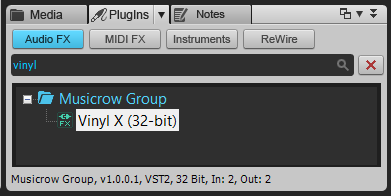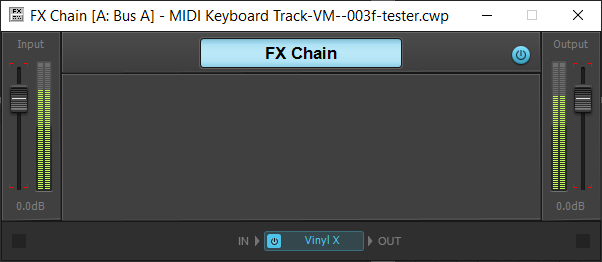-
Posts
6,067 -
Joined
-
Days Won
1
Everything posted by user905133
-

When Cakewalk is running, listening to Music files is disabled?
user905133 replied to Yellowpen's question in Q&A
Based on my personal experience on my Audio PC, it really depends on your system (devices, support software, and settings--including Window's Sound settings). It can be done, though. 2020-09-15: Edited to remove references to (1) a different media player than the one mentioned, (2) a different online source of music, (3) references to a different audio device and support software, and (4) a suggestion for looking at one possible cause and possible solution for the problem mentioned. -
I tried Chrome and FF before. Just tried Opera (opened quickly) and AVG's Browser (super slow to open). Hope the experiences from other users with this specific issue works for you. There might be other threads on the issue, too.
-
Creative Labs seems to have totally abandoned Emulator X for years with no signs that they place any value on it. Maybe Bandlab can pick it up and give it to the Cakewalk developers?
- 28 replies
-
- 1
-

-
- sampler in cakewalk
- cakewalk needs a sampler
- (and 1 more)
-
JMO: I suspect this quote from the popularity contest poll you mention might be causing more harm than good because it sets up a false expectation for many PC users who have no or limited experience with SONAR/Cakewalk. Cakewalk is a robust, extremely flexible / customizable piece of software that has many steep learning curves. ". . . you've got literally nothing to lose . . . " clearly refers to the $0.00 price tag. However, it gives a false impression that time spent learning to use the software is trivial (". . . by trying this one"). If fairness to the OP, "screwing around" with the program fits with "trying this one."
-
I just went there; it worked. Maybe try a different browser? I had problems like that in the past with some protection software (e.g., script blockers, etc.).
-
I have no knowledge about this error, but I do remember seeing other threads mentioning it. FWIW here's another thread . ADDENDUM: Evidently the link to Visual C distributables in that thread are in German. See discussion below.
-
If I understand you correctly, you have the current or a recent version of Cakewalk and previously created something named "Lense" which shows up as a choice along with current Workspaces. While you could delete it, you can just ignore it for now in case you want to tweak it later. I seem to recall that with changes to the Workspaces apparatus in recent months, I went through a number of my personal Workspaces (a) to see if they still worked to my satisfaction and (b) to make tweaks to conform to the new and improved Workspaces apparatus. Without going into the details, maybe you could choose one of the factory Workspaces (e.g., "Advanced", or "None" as suggested) and then test some of the issues--such as the ones you mention here--track height and synth rack disappearance. If that works, you could just tweak it and turn it into a new "Lense" by re-saving it as "Lense." I hope this helps. BTW, I agree--creating custom workflows/UIs with Workspaces is mind-boggling. I have some that work well for my needs. As I said, I came to them with lots of trial-and-error. If I were to try to create a new one for a new/different personal workflow, I am sure I would be back close to the start, though I do have some mental scars that say, "Don't try it that way; it'll turn into a dead end."
-
I have been trying to understand what people in different posts mean by sampler. The first sampler I used was the Emulator II [IIRC]. I was aware of some other manufacturers from that era through to the Emulator IV / EOS / Ultra series and then the software versions [Emulator X, X2, X3]. I have seen a few other software "samplers" and sample playback software ROMpler/RAMplers. Are the plug-ins/programs mentioned in paragraph 1 above sample playback programs, or (A) are they full-fledged samplers with (1) the ability to record audio from any source (analog or digital), (2) the ability to digitize/tweak/modify/edit/apply built-in functions to/etc. recorded audio, (3) the ability to load previously recorded/tweaked/etc. audio "samples" [including short waveform snippets and longer sections of audio that some might call phrases], (4) the ability to map samples (including standard techniques of layering, keysplitting, multisampling, etc.) across the full range of musical keyboard (or any part of the keyboard), and (5) the ability to build those samples into patches/presets/programs to be played in realtime on MIDI-capable devices, with (B) a complete and fully implemented multi-timbral synth engine (with a minimum of 32 midi channels, each channel having a full set of controllable parameters) including an extensive system exclusive implementation? When I have seen "sampler" used in this thread (above) and other similar threads of late, it is not clear that people have in mind the same thing that I think of as a sampler. Your explanation above is an excellent attempt to start addressing the question, "What do people here mean by sampler?" If all the proponents agree that they are requesting a fully integrated phrase sampler, that is something different. Unless I am mistaken, a major overhaul of the media browser might be useful as a "phrase sampler" with some totally new functionality including the features of a full-fledged audio recorder/wave editor. For the synth engine of this new, integrated sampler, I am not sure there has been sufficient discussion of what that synth engine would look like. Personally, I would like it to have sliders and full access to FX (not unlike Z3ta), a complete multi-channel midi implementation, and sample/preset mapping. But those are just my personal preferences. Your use case example also helps to clarify what you mean by phrase sampler (and how you might use it). The recording and editing of audio you describe and then the dropping of the audio into slots and having those mapped to single notes definitely describes some features of traditional samplers, but there are so many features not mentioned. I can imagine that with all the variations, the developers could come up with something and then we'd find out (1) its not what everyone was clamoring for and (2) it is not a complete sampler. BTW, before I discovered Cakewalk had risen from the ashes, I bought the "pro" version of another DAW that included a full-fledged sampler. Compared to the hardware and software samplers I have used, it was horrible to work with, not very good when it worked, and way over-priced. Thanks for the clarifications I cited above and for the extended list of features you'd like to see. Maybe it would help if all the possible features of a phrase sampler (or complete sampler/editor/synth package) were in a poll and people could choose the 5-10 features they felt were most important to have in an integrated sampler. If there is an option to convert samples and presets from a variety or formats used by traditional and recent software samplers/ROMplers/RAMplers, that would be one of my preferences.
- 28 replies
-
- 1
-

-
- sampler in cakewalk
- cakewalk needs a sampler
- (and 1 more)
-
I am a fan of Workspaces [formerly Lenses] because the way I choose to use it, I find it helps me take advantage of Cakewalk's extreme flexibility. That being said, it took me a lot of trial-and-error (developing different temporary custom Workspaces) to begin to understand and make use of Workspaces efficiently. I am confused by your use of "lenses" here. Do you mean "Workspaces?" Are you using an older version of Cakewalk/SONAR? Over the past several updates, there have been a number of changes to Workspaces. So, in order to understand what might be going on, what version/build of Cakewalk are you using? In a previous update, a new option was added that might help with you experiences in combination with "None" as has been suggested above. [It might be worth looking to make sure that option is off.] From the 2020.08 Feature Overview:
-
I have been using Cakewalk since the MS-DOS Version. Based on accumulated experience (learning + repeated usage) for me some things are extremely "intuitive"--meaning, I don't have to think: the ear-brain-hands work on "autopilot." New features and old features which I did not take the time to teach myself over the years are "less intuitive"--meaning they each have a "learning curve." Sometimes, internalizing these is more challenging for me than others (steep/sharp learning curve, overcoming years of doing it by tried-and-true ("intuitive" / "automatic" steps), mental block esp. with a feature I have never seen before, etc.). Seasoned users have given you some excellent insights above (and I expect more might follow); there are many video tutorials on line (in fact, there are ones in many different styles of presentation); etc. If you want to bail on Cakewalk, I cannot imagine anyone will fault you for it. However, as others have noted, Cakewalk is full-featured / robust / complex. In addition, there is quite a bit of customizability. Perhaps before moving on, you might want consider the comments of others.
-

Help with plugin sounds in a single track
user905133 replied to Shivali's topic in Instruments & Effects
According to the website, "Note: To sequence the field recordings you can use notes C-1 to F-1 in the Piano roll." I did not download "Serenity," but it seems to be saying that to play the different sounds, create a song using the notes from C-1 to F-1. They specify using the piano roll, but I assume you can also use a keyboard controller. Your image shows the virtual computer keyboard. Did you try the virtual music [aka piano] keyboard? -
I know very little about VST2s v. VST3 and will gladly defer to others; however, recently I discovered that one VSTi I own (and like!) receives program change commands from my usb keyboard under the VST2 version but not with the VST3 version.
-

Do you use the empty space below the Tracks pane?
user905133 replied to Starship Krupa's topic in Feedback Loop
-
I would like a switch added to the Inspector-based Arpeggiator so I (and other users) can use an Arpeggiator to affect a single MIDI Channel. Rationale: At present (unless I am mistaken) Remote Control MIDI (MIDI Learn) does not work with the Arpeggiator. I suspect the reason is that the Arpeggiator is capable of sending data to Multiple MIDI channels. My hope is that by providing a switch on the Arpeggiator itself to set it to Single Channel Mode, Remote Control MIDI (MIDI Learn) will work properly.
- 1 reply
-
- 1
-

-
According to a manual I found on line, the knobs have several modes. Do you have them set for MIDI Mode? (I found the reference in the section for "HyperControl Mode Button.")
-
@CellotomicsYes--Voltage Modular by Cherry Audio. ? (It handles arpeggiation to my liking!!) @pwalpwalAs for the Inspector-based Arpeggio being controlled by remote control MIDI, so far as I can tell, it seems to be a complex issue that might even be the result of some design decisions rather than a bug. Also, it might be that despite my efforts to get it working, there is a setting somewhere that would make it work the way normal remote control/MIDI learn works. My last effort on this issue was to try to design a feature request that would allow Arpeggiator users to set the MIDI routing such that it works on a single midi channel thereby allowing remote control to work properly. Unfortunately, I cannot find a MIDI signal flow chart comparable the audio signal flow chart. Without that, I didn't feel comfortable proposing a routing switch (and I got tired of trying to create my own). If I remember correctly, one idea I was pursuing that the problem had to do with the Arpeggiator's multiple channel ability. I don't remember the details, but if others are interested in the issue, I could try to retrace my steps.** **ADDENDUM: I back tracked my explorations a little. The Inspector-based Arpeggiator is capable of sending data to one or multiple channels. I suspect this ability interferes with the proper functioning of remote control MIDI. For my intended usage I would prefer to not have the multi-channel ability on a single Arpreggiator and to have remote control working properly. That's why when I last explored this issue I was looking into MIDI data flow in order to make a feature request that would turn each individual Arpeggiator into a single channel function. I believe that in order for it to have multi-channel abilities, it cannot respect channelized midi commands. Ergo, not a bug but a design decision. I could be wrong, though. BTW: Thanks reminding me of this issue. I made a formal feature request. At first I thought I was the only one interested in controlling the Arpeggiator via Remote Control MIDI, but evidently others are interested, too. Maybe someone official will see the request and will tell us how it can be done. If not, maybe it can be implemented. ?
-
Personally, I think it would be a great feature to be able to have multiple adjustable panes within the Multidock--much like we have the track pane and the bus pane in the Track View and like we have track, bus, and hardware output panes in the Console View.
-
Did you try just downloading Cakewalk itself and then doing the add-ons later? Some people have mentioned that worked for them.
-
I didn't mention it but I also tried it with a loop (wav file) I dropped into a track. That didn't work either. Right now my XP PC is not accessible, otherwise I would have tried it. Other things I tried (without success): combining the split audio track (didn't think that would affect anything), using automation tracks for the 3 knobs--since they exposed to Cakewalk (didn't think that would work either), I even tried editing some Modulation CCs to different CCs in Event View (didn't think that would work either because the manual clearly says to use "Modulation." I did not try different midi channels, though. I mention all these in case it helps someone think of other possibilities. Not sure what they mean here (above); maybe someone else might know if "delay modulation" (whatever that is) is affected by some Cakewalk setting. I tend to either use lfo modulation or map the CC to another controllable parameter. Good luck with it!! (If I think of anything else, I will give it a try--because for me, its more fun than Soduko, Cryptograms, and other sorts of diversions. ?
-
Comments written yesterday but not posted: I was curious about this, so I found, downloaded, and installed a demo version (1.09 from 2006). I put it in the fx bin on the audio track of a vsti. I tried a number of settings for the 3 knobs. My usb keyboard's modulation wheel is clearly going to the midi track. I hear the lfo modulation of the vsti, but Vinyl Boy doesn't scratch. I do hear the white noise, so I know it is in my audio chain. Maybe someone else can get it to work in Cakewalk New comments: Today I tried routing the audio portion of a vsti to a stereo bus and putting "Vinyl X" in the fx bin there. As far as the vsti, that works as expected. Plus, the bus has the vsti audio and the white noise from the demo version of the fx. My mod wheel affects the vsti audio, but there is no scratching effect. Cakewalk seems to see it as a 32-bit audio FX plug-in with 2 ins and 2 outs. The three knobs show up as FX controls where you would expect them to show up. I have not tried tweaking properties, yet. ADDENDUM: Convert to FX Chain works; in and out levels seem to work. I could probably add the 3 knobs, but that won't help with the MIDI Issue. Just showing here that Cakewalk can display audio in and audio out. The white noise indicating it is a demo plug-in only shows up on the output. BTW, the manual says it is for Windows 95 thru Windows XP. Maybe it will work on an XP PC?
-
This sounds very familiar--with MConvolutionEZ now showing up. IIRC I solved it by going to the default Cakewalk plug-in layout instead of one of my own. I forgot how to do that, but I believe that's what solved it. BTW, I liked it so much, I sprung for the Multi-Band version when it was on a half-price sale.
-

SI - String Section C3 and F3 stops playing
user905133 replied to Bob Haby's topic in Instruments & Effects
FWIW, I yesterday I tested a few SI-String Section programs (approx. 10-12) and only about 35-40% failed to loop on C3 and F3. -

Melodyne 5 problems, anyone else see issues?
user905133 replied to Jack Hawk's topic in Cakewalk by BandLab
I don't really have Melodyne, but from what I understand via comments in the forum, Cakewalk uses Melodyne somehow behind the scenes for converting audio to MIDI. I used to be able to drag an audio file into Cakewalk, the transport display would give me messages saying there is some sort of conversion going on, and when it was done, I had midi notes in the track in staff view. Recently, however, Cakewalk spins its conversion gears but there is absolutely no MIDI data in the track. -

SI - String Section C3 and F3 stops playing
user905133 replied to Bob Haby's topic in Instruments & Effects
I was curious, so I tried it out. (I never use SI-String Section.) There seems to be a looping problem with some presets (e.g., Default) and not others. I also experienced some looping artifacts with other notes with some of the presets. -

Curious- Why Use a Control Surface?
user905133 replied to razor7music's topic in Cakewalk by BandLab
JMO: Its all personal preference; there is no one right way. For example, I like sliders as opposed to knobs, keypresses, mouse clicks, etc. So for me using a couple of nanoKontrols as midi controllers works well for my eye-ear-brain-hand coordination. Also, my preferred usb keyboards have sliders (in addition to knobs). Purely personal choice. For me, moving sliders just feels so comfortable. PS: To be clear, for some tasks I use keyboard shortcuts, for other things mouse movement/clicks, menus and dialog boxes, etc.


